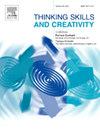从算法到艺术:通过创意编码与智能设计的跨学科融合,促进高中生的创造力
IF 4.5
2区 教育学
Q1 Social Sciences
引用次数: 0
摘要
创造力是高中生的一项重要技能。本研究采用基于项目的学习(PBL)框架和5E教学模式,在一门为期18周的高中技术课程中实施了跨学科整合的创意编码与智能设计课程,旨在考察跨学科整合课程对培养学生创造力的影响。选取华中地区某公立高中三个完整班级的150名高二学生进行准实验研究,实验组(N = 49)参加跨学科整合课程,对照组1 (N = 49)接受单一的创意编码课程,对照组2 (N = 52)接受单一的智能设计课程。通过创造性思维能力和创造性产出得分的前测和后测收集数据,并使用配对样本t检验、单向ANCOVA和独立样本t检验进行分析。结果表明,跨学科融合课程对高中生的创造性思维有较高的促进作用。但实验组和对照组1在创意上没有显著差异,实验组和对照组2在阐述上也没有显著差异。此外,跨学科整合课程的学生产生了更好的创造性产出,尽管在决心维度上与对照组1相比没有显著差异。总体而言,以PBL框架和5E教学模式开发的跨学科整合课程比单一学科课程更有效地促进创造力。这些发现有助于跨学科课程设计的理论与实践,并为教育工作者促进学生的创造力提供有价值的指导。本文章由计算机程序翻译,如有差异,请以英文原文为准。
From algorithms to artistry: Promoting high school students’ creativity through interdisciplinary integration of creative coding and smart design
Creativity is a critical skill for high school students. This study implemented an interdisciplinary integration of creative coding and smart design course developed with the project-based learning (PBL) framework and the 5E instructional model in an 18-week high school technology course, aiming to examine the impact of the interdisciplinary integration course on fostering students’ creativity. A quasi-experimental study was conducted with 150 sophomore high school students from three intact classes at a public high school in central China, comprising an experimental group (N = 49) who participated in the interdisciplinary integration course, control group 1 (N = 49)who received a single creative coding course, and control group 2 (N = 52) who received a single smart design course. Data was collected through pre-test and post-test of creative thinking skills and scores on creative outputs, and analyzed using paired samples t-tests, one-way ANCOVA, and independent samples t-tests. Results showed that the interdisciplinary integration course promoted higher levels of high school students’ creative thinking. But no significant difference was observed between the experimental group and control group 1 in originality, nor between the experimental group and control group 2 in elaboration. Additionally, students in the interdisciplinary integration course produced superior creative outputs, though no significant difference was observed in the resolution dimension compared to control group 1. Overall, the interdisciplinary integration course developed with the PBL framework and the 5E instructional model proved more effective in promoting creativity than single subject courses. These findings contribute to the theory and practice of interdisciplinary course design and provide valuable guidance for educators in promoting students’ creativity.
求助全文
通过发布文献求助,成功后即可免费获取论文全文。
去求助
来源期刊

Thinking Skills and Creativity
EDUCATION & EDUCATIONAL RESEARCH-
CiteScore
6.40
自引率
16.20%
发文量
172
审稿时长
76 days
期刊介绍:
Thinking Skills and Creativity is a new journal providing a peer-reviewed forum for communication and debate for the community of researchers interested in teaching for thinking and creativity. Papers may represent a variety of theoretical perspectives and methodological approaches and may relate to any age level in a diversity of settings: formal and informal, education and work-based.
 求助内容:
求助内容: 应助结果提醒方式:
应助结果提醒方式:


